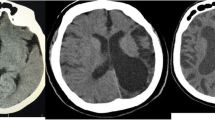Summary
We report characteristic and morphometric changes of cranial computed tomography (CT) with increasing age in 56 patients with Down's syndrome aged from 0 month to 37 years. Patients were compared with 142 normal controls aged 0 to 59 years. Width of ventricles, Sylvian fissures, posterior fossa, pons and cisterna magna were measured on CT. The incidences of the cavum septi pellucidi, cavum vergae and cavum veli interpositi and high density in the basal ganglia were examined. There was high incidence (10.7%) of bilateral calcification of basal ganglia in Down's syndrome, although that of pineal body and choroid plexus calcification was similar in Down's syndrome and controls. Basal ganglia calcification is more frequently seen in young Down's syndrome and may be related to the premature aging characteristic of Down's syndrome. The CT in Down's syndrome showed relatively small posterior fossa, small cerebellum, small brain stem and relatively large Sylvian fissures in those under one year of age. There was a high frequency of midline cava and large cisterna magna. There were no significant atrophic changes on CT except after the fifth decade comparing with controls.
Similar content being viewed by others
References
Lemire RJ, Loeser JD, Leech RW, Alvord EC (1975) Normal and abnormal development of the human nervous system. Harper & Row, Maryland pp 395–396
Rehder H (1981) Pathology of trisomy 21 with particular reference to persistent common atrioventricular canal of the heart. In: Burgio GR, Fraccaro M, Tiepolo L, Wolf U (eds): Trisomy 21. Springer, Berlin Heidelberg New York, pp 57–73
Tolksdorf M, Wiedmann HR (1981) Clinical aspects of Down syndrome from infancy to adult life. In: Burgio GR, Fraccaro M, Tiepolo L (eds) Trisomy 21, Springer, Berlin Heidelberg New York, pp 3–31
Ropper AH, Williams RS (1980) Relationship between plaques, tangles, and dementia in Down syndrome. Neurology (Minneap) 30: 639–644
Akimoto H, Maki Y, Ono Y, Nose T, Yoshizawa T (1983) Evaluation of the cerebral ventricular system and cortical sulci associated with aging on CT. Brain and Nerve (Domestic Edition) 35: 139–147
Meese W, Kluge W, Grumme T, Hophgenmüller W (1980) CT evaluation of the CSF spaces of healthy persons. Neuroradiology 19: 131–136
Barron SA, Jacobs L, Kinkel WR (1975) Changes in size of normal lateral ventricles during aging determined by computerized tomography. Neurology (Minneap) 26: 1011–1013
Hirashima Y, Shindo K, Endo S (1983) Measurement of the area of the anterior horn of the right lateral ventricle for the diagnosis of brain atrophy by CT. Neuroradiology 25: 23–27
Koller WC, Cochran JW, Klawans HL (1979) Calcification of the basal ganglia: Computerized tomography and clinical correlation. Neurology (Minneap) 29: 328–333
Sachs C, Ericson K, Erasmie U, Bergström M (1979) Incidence of basal ganglia calcifications on computed tomography. J. Comput Assist Tomogr 3: 339–344
Murphy MJ (1979) Clinical correlations of CT scan detected calcifications of the basal ganglia. Ann Neurol 6: 507–511
Cohen CR, Duchsneau PM, Weinstein MA (1980) Calcification of the basal ganglia as visualized by computed tomography. Radiology 134: 97–99
Brannan TS, Burger AA, Chaudhary MY (1980) Bilateral basal ganglia calcifications visualised on CT scan. J Neurol Neurosurg Psychiatry 43: 403–406
Aii H, Kameyama M, Nakano Y, Handa J (1980) Calcification of basal ganglia on computed tomography. Brain and Nerve (Domestic Edition) 32: 971–979
Merikangas JR, Marasco JA, Feczko WA (1979) Basal ganglia calcification in Down syndrome. Computr Tomogr 3: 111–113
Wisniewski KE, French JH, Rosen JF, Kozlowski PB, Tenner M, Wisniewski HM (1982) Basal ganglia calcification (BGC) in Down's syndrome (DS)-another manifestation of premature aging. Ann New York Acad Sci 396: 179–189
Malamud N (1964) Neuropathology, In: Stevens HA, Heber R (Eds) Mental retardation. Univ Chicago Press, Chicago, pp 429–452
Lowenthal A, Bruyn GW (1968) Calcification of the striopallidodentate system. In: Vinken PJ, Bruyn GW (Eds): Handbook of clinical neurology. North-Holland, Amsterdam, 6: 703–729
Adachi M, Wellman KF, Volk BW (1969) Histochemical studies on the pathogenesis of idiopathic non-arteriosclerotic cerebral calcification. J Neuropathol Exp Neurol 27: 483–499
Author information
Authors and Affiliations
Rights and permissions
About this article
Cite this article
Ieshima, A., Kisa, T., Yoshino, K. et al. A morphometric CT study of Down's syndrome showing small posterior fossa and calcification of basal ganglia. Neuroradiology 26, 493–498 (1984). https://doi.org/10.1007/BF00342687
Received:
Issue Date:
DOI: https://doi.org/10.1007/BF00342687




